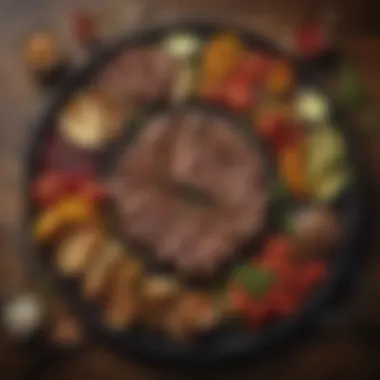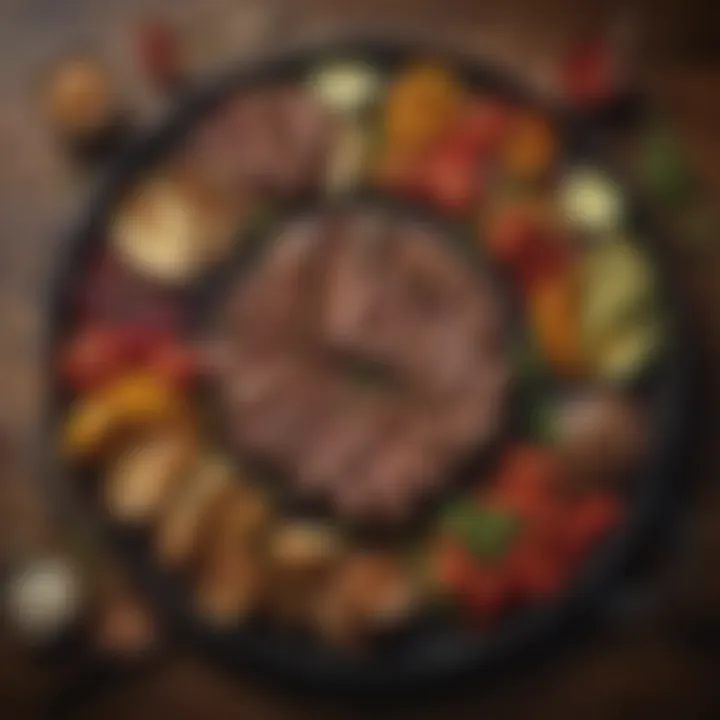A Comprehensive Guide to Grills and Accessories: Elevate Your Cooking Experience


Intro
Grilling is more than just cooking; it’s a passion, a way of life for many. Whether you are a novice BBQ enthusiast or a seasoned grilling aficionado, understanding the complexities of grills and accessories can enhance your experience immensely. This guide provides a comprehensive overview of different types of grills available in the market, the essential accessories that can elevate any grilling session, and effective maintenance tips to keep everything operating smoothly.
Throughout this dialogue, access the art and science behind grilling will be simplified, making it accessible for all audiences. If quality cooking is your goal, knowing what a grill can do, and how to optimize your tools and techniques is essential. The variety in approaches allows for transformation in flavors and textures, presenting boundless possibilities.
Would-be chefs must see that selecting the right type of grill is only the beginning. Mastery of accessory usage and understanding the significance of proper care can yield significantly more flavorful results. By the end of this exploration, you should be well equipped to tackle any grilling challenge, ultimately bringing joy to your gatherings with fuss-free moments and tantalizing meals.
Now, we'll explore our standout grilling recipe that embodies the essence of good BBQ.
Recipe Highlight
- Flame-Grilled BBQ Ribs
The magic of perfecting meat is extraordinary, particularly with ribs placed on the grill, where low and slow meets mouthwatering results. The Flame-Grilled BBQ Ribs are sure to impress at gatherings or quiet dinners.
Essential Ingredients:
- 2 racks of pork ribs
- 1 cup of BBQ sauce (your choice)
- 2 tablespoons of brown sugar
- 1 tablespoon of smoked paprika
- 1 teaspoon of garlic powder
- Salt and pepper to taste
Preparation Time: Approximately 2 hours
Servings: 4-6
Step-by-Step Instructions
- Preparation: Start by preheating your grill to medium heat, ideally around 300°F.
- Marinating: Use kitchen scissors to trim the ribs if needed. Rub the brown sugar, paprika, garlic powder, salt, and pepper all over the surface of the ribs.
- Grilling: Place the ribs on the grill and cover. Cooking time should be roughly 1.5 hours, flipping occasionally.
- Applying Sauce: For final 15 minutes, brush BBQ sauce generously on top of the ribs for a sticky and smoky finish.
- Checking Doneness: Ensure the ribs are tender and fully cooked before serving. Current internal temperature should be at least 145°F.
Cooking Tip: Avoid scorching the ribs by managing grill heat. If you notice uneven spots, position ribs differently to mitigate this issue.
Variations and Substitutions
To make this recipe versatile:
- You can substitute pork with beef or lamb ribs based on taste preference.
- Alternatively, use marinades like teriyaki or yogurt-based sauces for a fusion effect.
- Looking to spice it up? Add chili flakes or switch to a sweeter sauce for contrast.
Pair the ribs with cornbread, baked beans, or a fresh coleslaw for balance.
Time-Saving Cooking Tips
Successfully planning saves time:
- Pre-cut and season ribs a day in advance.
- If you plan multiple meals, pre-marinate several proteins and freeze.
- Utilize foil reduces cleaning time while allowing even cooking—wrap ribs halfway through.
Tools for Efficiency
Consider investing in a good knife, cutting board, and marinade injector to assist in reducing overall prep time. A meat thermometer ensures safe cooking.
Nutritional Information
Each serving of the ribs approximately contains 450 calorie.
Important nutrients include protein and iron from the meat. Higher levels of carbohydrates can be attributed to BBQ sauce quantities added.
This dish can be gluten-free by switching to certified sauces and adaptable regarding keto-friendly variations, given sugar is managed.*
Preface to Grilling
Grilling is more than just a cooking technique. It represents a way of life for many culinary enthusiasts and casual food lovers alike. In this section, we will explore the importance of grilling, touching upon its popularity and cultural significance. Understanding these elements gives depth to the overall grilling experience, thus enriching one's culinary adventures.
The Popularity of Grilling
Grilling has surged in popularity across various demographics. The ease and convenience of grilling make it a favored method for outdoor events. According to recent surveys, the number of people who grill regularly has steadily increased over the years embodying a unique blend of both tradition and modern lifestyle.
Reasons for Popularity
- Seasonal Appeal: Grilling often coincides with warm weather, encouraging social gatherings, picnics, and barbeques.
- Flavor: The unique smoky flavor achieved through grilling is hard to replicate using conventional cooking methods.
- Health: Grilling often uses less fat than frying or sautéing, making it a preferred choice for health-conscious individuals.
- Versatility: A wide range of foods, from meats to vegetables, can be cooked on a grill, accommodating diverse dietary preferences.
The social aspect of grilling cannot be overlooked. Shared experiences around the grill, whether in backyards or parks, foster connection and camaraderie.
Cultural Significance of Grilling
Grilling not only satisfies hunger but also carries immense cultural weight in various regions and communities. It showcases social practices, culinary traditions, and even the concept of hospitality.
Key Cultural Highlights
- Culinary Traditions: In many cultures, grilling is integral to celebratory events such as holidays or family gatherings, signifying community and bonding.
- Regional Varieties: Different parts of the world boast unique grilling styles. For example, in the southern United States, barbeque pits are a cornerstone of communal gatherings. In contrast, Argentinian Asado is almost a ritual involving the whole family.
- Nutritional Practice: In some nations, grilling is a way to prepare and preserve ingredients, combining practicality with taste.
The significance of grilling transcends culinary practices; it captures essences of love, family, and tradition.
In summary, understanding grilling’s popularity and cultural significance lays the foundation for the practice. From facilitating social connections to maintaining culinary heritage, grilling is a multifaceted experience that elevates the joy of cooking.
Types of Grills


When embarking on your grilling journey, understanding the types of grills available is crucial. Each grill type offers unique benefits, allowing enthusiasts to choose the one that best fits their cooking style and preferences. Additionally, the type of grill significantly impacts the flavor profile of the finished dish. This section will delve into the standout features of various grill types, drawing attention to their individual characteristics, advantages, and considerations when selecting the right one.
Charcoal Grills
Charcoal grills are a popular choice for those who appreciate the rich, smoky flavors they impart to food. The main benefit of using charcoal is the ability to reach high temperatures, ideal for searing meats. Moreover, charcoal offers different flavor profiles depending on the type of charcoal used. Here are a few key features:
- Heat Retention: Charcoal burns hotter for a more extended period, making it advantageous for rigorous cooks.
- Versatility: These grills can be used for direct heat applications or indirect grilling, accommodating various cooking methods.
- Affordability: Often less expensive than gas grills, they provide an economical grilling option for many households.
Despite these advantages, there are some drawbacks. Charcoal grilling can be time-intensive as you must wait for the coals to ash over before cooking. Cleanup is also typically messier due to the ash produced during cooking.
Gas Grills
Gas grills offer convenience and precision. Most gas grills run on propane or natural gas, allowing for easy ignition and loosening the food. Here’s what makes them stand out:
- Ease of Use: With a simple push of a button, your grill ignites, making it amenable for novice cooks.
- Control: Gas grills allow for precise temperature control, crucial for cooking techniques like roasting or grilling delicate items.
- Minimal Cleanup: They usually produce less mess overall compared to charcoal grills.
However, some grilling enthusiasts argue that gas cannot replicate the flavor superiority of charcoal. Additionally, the reliance on gas sources may limit where you can effectively set up and use the grill.
Electric Grills
Electric grills have gained traction for their safety and accessibility. They’re ideal for those living in apartments, where open flames are not permitted. Their benefits include:
- Convenience: Plugging in yields a quick heating source. Users can start grilling almost immediately, and these grills typically feature easy-to-clean surfaces.
- Healthier Option: Electric grills often cook with less grease, promoting a lighter grilling technique.
However, heat control may differ from more traditional methods, with electric grills being less effective at high-temperature cooking. Additionally, some grilled items might rely on charcoal or gas for authentic flavors.
Pellet Grills
Pellet grills emerged as a choice for many BBQ lovers who want the best of both worlds. They burn wood pellets and can serve as both a grill and a smoker:
- Flavor: They provide a robust flavor profile due to the variety of wood pellets available, such as hickory or mesquite, enhancing the outdoor cooking experience.
- Versatility: Pellet grills cater to multiple cooking styles, allowing users to smoke, grill, or bake.
Nevertheless, they do require electricity, making them less portable. This necessitates planning where they will be used beforehand, especially on camping trips or tailgate settings.
Portable Grills
Portable grills have become essential for those who enjoy outdoor lifestyles, traveling, or tailgating. They generally use either propane or charcoal and possess various advantages:
- Compact Design: Typically lightweight and easy to transport, these grills cater to individual or small group servings.
- Affordability: Often less expensive, portable grills make for good budget options compared to full-size grills.
- Convenient Size: Suitable for those with limited outdoor spaces or smaller balconies.
However, the small cooking area may limit meal preparation. You may also have to recalibrate your cooking styles, focusing on quick and easy meals.
Understanding the variety of grills enhances one’s grilling experience. Taking into account personal preferences and cooking habits will lead to an informed decision on which type of grill is most suitable.
Key Features to Consider When Choosing a Grill
When selecting a grill, several features should be examined closely. Key elements such as size, fuel type, and additional features significantly influence the grilling experience. Understanding these aspects not only guarantees a satisfactory purchase but also enhances satisfaction while grilling. The decision can streamline cooking processes and even uplift enjoyment when preparing meals outdoors.
Size and Cooking Area
Size and cooking area are fundamental considerations when choosing a grill. The available space in your outdoor area often dictates the size of the grill you can accommodate. A level must be struck between how much space is utilized and the size of gatherings you generally host.
Grills come in various sizes, from compact models suitable for small kitchens or balconies to expansive ones intended for larger family or friends forasts. A common misconception is that larger is always better. However, if you mostly cook for two or three people, a smaller grill could be more practical and efficient.
The cooking area directly impacts how much food can be prepared simultaneously. For instance:
- A cooking area of over 400 square inches is generally ideal for hosting family BBQs.
- Smaller grills may have between 200 and 300 square inches, adequate for quick meals.
Analyzing cooking requirements and anticipated guest sizes can guide you in choosing the best grill size.
Fuel Type
The fuel type is another crucial consideration as it influences how grills perform and flavor the food prepared. Common fuel types include charcoal, gas, electric, and wood pellets, each with its benefits.
- Charcoal: This fuel delivers a distinct smoky flavor, appreciated by traditionalists. Certain durable choices like the Weber Original Kettle can bring authentic grilled tastes for food lovers.
- Gas: Propane and natural gas options heat up quickly, providing convenience. Ney the Weber Genesis II series is practical for those who desire a balance of flavor without longer cooking times.
- Electric: Ideal for urban dwellers and those with space constraints, electric grills may not offer the same intense flavor, but they are easier to control and clean, offering simplicity for beginners.
- Wood Pellets: These combine smoky taste and ease of use. Traeger, a popular brand with diverse wood flavors, enhances grill outcomes without complexity.
Consider personal cooking styles and flavor preferences when evaluating fuel types, as it fundamentally affects the grilling conversion.
Additional Features
Finally, additional features can distinguish one grill from another. Modern grills often come equipped with a range of functionalities that elevate grilling. Some beneficial features to explore include:
- Side Burners: These allow multi-tasking, enabling sauces or sides to be prepared simultaneously.
- Grill Thermometers: Built-in gauges on more advanced models can help monitor cooking temperatures, ensuring perfect doneness.
- Storage Space: Having shelves or cabinets can be essential in organizing tools and spices conveniently.
Evaluating what features align with personal cooking methods can lead to a happier grilling experience.
Essential Grill Accessories
Grill accessories form the backbone of a successful grilling session. They enhance functionality and safety and contribute to the overall grilling experience. Having the right tools on hand can lead to better food quality, ease of use, and a delightful cooking atmosphere. The thoughtful selection of accessories complements your grill setup, making tasks smooth and efficient.
Grill Tools


Grill tools are essential for manipulating food on the grill, ensuring even cooking. These tools can greatly influence the outcome of your grilling.
Spatulas
Spatulas are critical for flipping burgers or delicate foods. Their flat surface allows for easy handling without damaging the food. A key characteristic is the long handle, which provides control and keeps your hands away from the heat. A good spatula is often wide enough to support heavier items.
However, they come in various materials like stainless steel or silicone, each having its respective advantages and disadvantages. Stainless steel spatulas are durable and easy to clean, whereas silicone spatulas are non-stick and can be gentler on foods.
Tongs
Tongs are vital for grasping food from the grill. Their gripping mechanism allows for better control than using forks or spatulas. Their key characteristic lies in the spring mechanism, giving you quick access to release of food, essential for multitasking on the grill.
Although tongs are typically heat-resistant, choosing ones without sharp edges can prevent scratching your grill’s surface. A good pair should also have a locking mechanism for easy storage when not in use.
Brushes
Brushes are particularly useful for applying sauces or marinades evenly on your food. They typically have bristles made from silicone or natural fibers, offering flexibility depending on your preference. One unique feature is the variety in brush head sizes, catering to outdoor cooking conditions and types of food being grilled.
Opt for brushes designed for heat exposure. This ensures the fibers do not melt during use. Some might find misplacing brushes easy if not stored correctly.
Protective Gear
Staying safe while grilling should never be overlooked. Protective gear shields you from heat and spills while maintaining comfort during the cooking process.
Oven Mitts
Oven mitts help protect your hands from high temperatures when handling hot food or grill accessories. They are typically made from heat-resistant materials with additional padding for comfort. Their interior has sometimes a thematic design and enhances both functionality and user satisfaction.
Furthermore, you should ensure they fit snugly enough to offer dexterity yet not too tight to inhibit movement. A proper fit improves safety and handling of grill items easily.
Aprons
Aprons shield clothing from splatters and spills during grilling. They often come with pockets, improving utility as you can store small tools nearby. The key characteristic of aprons includes easy-to-clean fabric or waterproof materials used by many manufacturers.
Possessing an apron not only maintains a clean appearance, it promotes a professional look as a home grill master. However, quality varies widely; thus, investing in a durable version is advised.
Grill Covers
Grill covers are vital for protecting your grill from weather, dirt, and other environmental factors. A good cover prevents rust and prolongs your grill's lifespan. Seek out custom fittings for each type of grill since a proper fit reduces the chance of water buildups. Durable materials resist wear and tear when used outdoors. Not using a grill cover could distress the look and effectiveness of your equipment.
Thermometers
Using thermometers can enhance over exactness while grilling. They ensure your meats are appropriately cooked for safety and achieve the desired doneness.
Digital Thermometers
Digital thermometers offer fast and precise readings, which are crucial for a perfect grilling experience. This style typically features an easy-to-read display. Their functionality includes an instant temperature reading.
It will help ensure food has reached a safe minimum internal temperature while avoiding overcooking. A downside could be the battery dependency; thus, keep spare batteries nearby.
Instant-Read Thermometers
Instant-read thermometers reduce the waiting period for taking temperatures. They are designed for quick insertions into cooked food, giving rapid feedback. Their primary benefit remains the ability to provide accurate readings in a matter of seconds.
However, caution is necessary since multiple uses typically reduce their condition due to thermal exposure. Selecting a high-quality brand can counteract this issue.
Accessorize your grilling experience with tools that promote safety, efficiency, and enhancing outcome.
Enhancing Flavor with Accessories
Enhancing flavor while grilling is not just an option; it is an essential aspect that elevates the quality of the food. Various accessories can boost the taste of your grilled dishes, ensuring that each bite is a delightful experience. Marinades and rubs, flavoring woods, and smoking tools expand the flavor profile, allowing chefs to tailor meals to specific tastes and preferences. Understanding how to use these tools and ingredients can transform a basic grilling session into a gourmet outing.
Marinades and Rubs
Marinades and rubs serve as the foundation for flavor enhancement. A marinade typically consists of liquids, such as oil, vinegar, or citrus juice, combined with herbs, spices, and sometimes sugar. Marinades infuse foods while they sit, tenderizing meats and bringing zest to vegetables. On the other hand, rubs are dry mixtures of spices, herbs, and seasoning blended to create a crust on the food. Both methods are versatile and can cater to different types of cuisines.
Key benefits of using marinades and rubs include:
- Flavor Depth: Both add layers of taste that grilling alone cannot achieve.
- Tenderizing Qualities: Acidic marinades break down proteins, making meats more succulent.
- Customizability: Individuals can personalize recipes by picking ingredients that suit their preferences.
Consider these simple tips for using marinades and rubs effectively:
- Always let the food marinate for adequate time depending on the type—fish might need less time compared to tougher cuts of meat.
- Keep an eye on salt content in rubs, as too much salt can overwhelm other flavors.
Flavoring Woods
Using flavoring woods takes grilling proficiency to the next level. Different types of wood confer unique flavors, from sweet to strong. For instance, hickory creates a robust smokiness, while applewood presents a milder, fruity aroma. Cherry wood can enhance the color and provide a subtle sweetness.
When employing flavoring woods in grilling:
- Choose Fruit and Nut Woods: These types impart pleasant tastes and are generally less aggressive than hardwoods.
- Soaking Wood Chips: Soaking chips in liquid can prolong their burn time and deepen the flavor infusion.


Experimenting with different woods can be both rewarding and enlightening, as it enriches each grilling experience.
Smoking Tools
Smoking tools come into play for those who wish to expand their flavor horizons even further. These accessories include dedicated smokers, smoke boxes, and smoking pouches that can be used on gas or charcoal grills. The fundamental purpose of these tools is to generate smoke, which combines with heat to enhance the taste of the grilled food.
Effective usage of smoking tools ensures richer experiences:
- Control Over Smoke Production: Specialists can regulate smoke levels based on the food type.
- Combining Flavors: Tools can be used with different wood types, allowing for hybrid smoking techniques that blend unique flavors.
Incorporating these accessories into your grilling routine can create distinctive taste profiles, warranting satisfaction for any discerning cook or food lover. Remember, enhancing flavor involves learning, experimenting, and delighting in the results.
To truly enjoy the flavors of grilling, invest time in exploring various marinades, flavoring woods, and smoking tools. The journey shapes your grilling identity.
Maintenance of Grills
The necessity of maintaining grills cannot be overstated. Regular maintenance extends the life of the grill, ensures safe operations, and enhances the quality of food being prepared. Proper care is essential to prevent rust, blockages, and other issues that can ruin your grilling experience.
Cleaning Techniques
Cleaning your grill should be done regularly for effective maintenance. The frequency depends on how often you use it. For instance, if you grill often, weekly cleaning can help maintain optimal conditions. Here are some steps to clean your grill:
- Preheat the Grill: Heat the grill on high for about 10 to 15 minutes before cleaning. This helps to burn off leftover food particles and makes cleaning easier.
- Brush the Grates: Use a grill brush to scrub the grates while they are still warm. This loosens food and grease buildup. A brass or stainless steel brush is effective for this.
- Empty the Drip Pan: Ensure to clean the drip pan that collects excess grease. This should be done after every grilling session to prevent flare-ups.
- Deep Clean Periodically: Disassemble parts like grates and burners for a deeper clean every few months. Use hot, soapy water to wash them, followed by rinsing to remove any residue.
- Inspect for Damage: Look for rust or breakage every time you clean. Fixing any issues early helps prolong the life of the grill.
By investing time in cleaning, you not only keep your grill looking good, but you also enhance its efficiency.
Seasoning Your Grill
Seasoning your grill adds a protective layer to the grates, preventing rust and keeping food from sticking. Here’s a simple method:
- Choose the Right Oil: Flaxseed oil, vegetable oil, or canola oil works well. They have high smoke points, making them ideal for grilling.
- Apply Oil: Spread a thin layer of oil on the grates using a paper towel. This can be done while the grill is still warm.
- Heat Up: Preheat the grill to a high temperature. This allows the oil to bond with the metal. Do this for about 30 minutes.
- Cool Down and Wipe: After using the grill, let it cool down. Then, wipe off any excess oil using a clean cloth.
This process should be done every few months, or when you notice food begins to stick more than usual.
Storage Recommendations
How you store your grill is also an important factor in its longevity. Here are some recommendations for proper storage:
- Cover the Grill: When not in use, use a durable cover to protect it from the elements. A good cover shields against moisture and dust, essential for outdoor grills.
- Store Indoors: If possible, bring a portable grill inside, especially during off-seasons. This can help avoid the wear and rust caused by outdoor conditions.
- Remove Propane Tanks: If you have a gas grill using propane, remove tanks and store them securely to prevent corrosion and potential danger.
- Find Dry Place: Always store your grill in a dry environment, reducing the chances of rust. If storing for a long period without use, consider applying a protective spray over multi surfaces.
Proper maintenance of your grill is a key consideration for enhancing your grilling experience. With effective cleaning, seasoning and correct storage, you ensure peak operation even for years in the future.
Safety Considerations
Ensuring safety while grilling is paramount for every outdoor cooking enthusiast. Proper awareness and protocols can avert accidents and health risks. The importance of safety measures in grilling transcends mere checklists and becomes fundamental for protecting oneself, one’s family, and guests. As you delve into grilling, understanding potential hazards will be factor in allowing a safe and enjoyable culinary experience.
Fire Safety
Fire safety should be one of the primary concerns whenever you grill. An open flame and overheating equipment present significant risks, especially in quick-changing weather conditions, such as gusty winds. Use grills in well-ventilated areas to reduce risks of gas buildup and smoke infiltration.
- Always monitor the grill while it is on;
- Keep flammable materials, including paper towels and cooking oil, away from the grill;
- Ensure that your grill is sturdy and placed on a stable surface to prevent tipping;
- Keep a fire extinguisher or a bucket of sand or water nearby in case of emergencies;
- Clean grease buildups regularly as they increase the likelihood of flare-ups.
By adhering to fire safety principles, grilling can be both an art and a secure activity.
It is also critical to understand specific types of grills. For instance, gas grills may pose a burn hazard if not handled with attention, while charcoal grills can contribute to more dangerous flare-ups if not managed cautiously. Knowledge about these risks is crucial.
Food Safety
Maintaining food safety while grilling is crucial in preventing foodborne illnesses. Proper food handling, along with maintaining the right cooking temperatures, ensures that the grilling experience is both delicious and healthy.
- Always wash your hands before handling food to avoid contaminating your ingredients;
- Use separate cutting boards for raw meats and vegetables to prevent cross-contamination;
- Cook meats to the proper internal temperatures: ground beef to at least 160°F, poultry to 165°F, and steaks to 145°F, ensuring to rest before slicing;
- Properly store any leftovers within two hours to minimize bacterial growth;
- For effectiveness, utilize instant-read thermometers to confirm that cooking has reached safe temperatures.
Food safety cannot be overlooked when it relates to the well-being of those who enjoy the grilled creations. Through conscious efforts in food preparation and cooking, guests and family can savor every bite without concern.
Finale
The conclusion of this guide captures the essence of the enjoyment and techniques of grilling. Grilling transcends mere cooking; it represents a communal activity. Shared meals prepared outdoors serve to strengthen bonds among friends and family. When one engages in grilling, it allows for creativity and experimentation. Integrating different flavors and grilling styles reflects personal preferences and showcases culinary skills.
A key takeaway from the article is the wide array of grills available on the market today. Each type of grill offers unique features tailored to specific cooking styles and lifestyle needs. Whether using a gas grill for its convenience or opting for a charcoal grill for the intricate flavor it imparts, understanding these differences allows you to choose the right equipment.
Essential accessories complement the cooking process, ensuring safety and enhancing flavors. By stocking up on the right tools, such as tongs, spatulas, and thermometers, one can elevate the grilling experience. Simplifying maintenance also cannot be ignored, as regular cleanings and proper storage ensure that your investment in a grill lasts longer, ultimately providing more enjoyable cookouts.
Order and safety are required when grilling, as keeping a tidy workspace helps prevent accidents and ensures food integrity. Practicing food safety reinforces the enjoyment of grilling, especially when serving others. Every element discussed earlier contributes to not just cooking food, but to creating enjoyable moments.
The art of grilling combines technique, flavor, and experience. It invites everyone, from novice cooks to seasoned chefs, to participate in a pleasurable journey. By embracing the information in this guide, readers are better equipped to dive into the world of grilling fully and confidently. Take pleasure in every grill mark and smokiness in your food; it is not just about what food tastes good, but about making the experience remarkable for you and those who share it.
"Grilling is not just about the food; it's a tradition interlaced with joyful memories and unbreakable bonds."
By focusing on personal enjoyment and understanding associated elements of grilling, you're more likely to succeed and cultivate lasting enjoyment. Rather, it's best to dive into what makes grilling an endless source of joy while you discover your signature techniques, leading to both satisfaction and a great time spent with loved ones.
Final Thoughts on Grilling and Its Enjoyment
Ultimately, grilling is more than preparing food. It engages the senses and allows individuals to connect over shared experiences. The smokes, sizzles, and aromas stimulate appetites and draw people together. Instead of focusing solely on outcomes, embrace each moment spent creating those memories.
With consideration for various grills and an emphasis on investing in good accessories, you're well-equipped. Personalization becomes important when developing unique flavors through marinades and rubs. Enjoy learning from mistakes; they can lead to great lessons in improving culinary techniques.
Find joy in the cooking process, collaborate, inspire, and learn together harmoniously. As you finish reading this comprehensive guide, keep in mind how grilling enhances connections among those who gather around. Outside enjoyment adds to the culinary experience, ultimately turning grilling into a lifeworld celebration.







